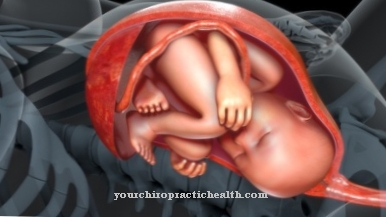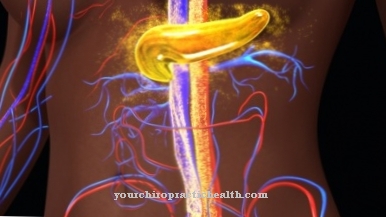Of the Aqueous humor pressure of the eye enables symptom-free and optimal vision. If something is disturbed in the sensitive interaction, serious visual disturbances can occur.
What is the aqueous humor pressure?

The aqueous humor is a clear, nutrient-containing liquid in the anterior and posterior chambers of the eye. Aqueous humor is similar in composition to blood serum, but contains less protein and no bilirubin. Around 98 percent of it consists of water, in which mainly amino acids, ascorbic acid, electrolytes, lactic acid and immunoglobulin G are dissolved. There are also traces of hydrogen peroxide.
A human eye produces around three to nine milliliters of aqueous humor in a day. This production is reduced a bit at night. In comparison, the eyeball has a volume of around 6.5 milliliters.
The aqueous humor is created continuously from the carbonic acid of the blood in the ciliary body (radiation body) on the middle skin of the eye and is released from there into the posterior chamber of the eye. Finally, through a tiny gap between the lens and the iris (iris), it also reaches the anterior chamber.
Most of the aqueous humor flows back into the bloodstream through the veins of the conjunctiva via the chamber angle and Schlemm's canal.
Function & task
With the circuit described, the aqueous humor supplies the lens and the innermost layer of the cornea with nutrients. In addition, with its immune content and constant circulation, it has the task of banishing pathogens and toxins from the inside of the eye.
The production and the subsequent outflow of aqueous humor are always balanced in a normally functioning eye. In this case, both eye chambers are always filled with aqueous humor. This also stabilizes the shape of the eye and the curvature of the cornea.
However, as soon as the outflow is obstructed or more aqueous humor has developed than can flow out, the internal pressure in the eye chambers and in the vitreous body increases. This space between the lens and retina, which is filled with a gel-like substance, puts a strain on the head of the optic nerve when there is increased pressure. This is an extremely delicate and sensitive area of the eye. Because of the increased intraocular pressure, the very sensitive fibers of the optic nerve head can be squeezed.
You can find your medication here
➔ Medicines for visual disturbances and eye complaintsIllnesses & ailments
If the optic nerve fibers begin to die, glaucoma (glaucoma) forms. The affected person has a limited field of vision. This process is slow and is not noticeable at first. At the onset of glaucoma, the restrictions only affect the edge of the field of vision. However, if the pressure load remains high, the field of vision gradually narrows. Finally, the restrictions affect the center of the field of vision, with no pain normally occurring.
For example, if left untreated, glaucoma can lead to loss of vision. It is estimated that around 2000 people go blind from glaucoma every year in Germany.
A timely consultation of the ophthalmologist for an effective treatment of an emerging glaucoma is strongly recommended. He will use simple means to measure the intraocular pressure to determine the extent of a possible glaucoma disease.
The harmless intraocular pressure moves, depending on age, in the order of 10 to 30 mmHg (millimeter mercury column, previously Torr). According to the definition, a mmHg is the static pressure exerted by a column of mercury one millimeter high. A healthy middle-aged adult has an intraocular pressure of around 21 mmHg. In older people, the internal pressure of the eye often increases a little.
If there is a severe case of glaucoma, the pressure can reach up to 70 mmHg. This serious event is accompanied by headache and eye pain and often nausea and vomiting. The patient suddenly becomes very sensitive to light and the affected eye feels very rigid.
Immediate medical attention is required in this emergency. For a certain time the eye can withstand a slightly increased pressure. Medically, this property is called tension tolerance. However, if the pressure has increased significantly over a longer period of time, there is a risk of permanent damage to the visual apparatus.
The aqueous humor pressure value can accordingly also be too low with a reduced formation of aqueous humor. The dangers then lie in the threat of retinal detachment, which can lead to blindness. Because only if the intraocular pressure is in the right range can it fix the retina in its intended position.
If the intraocular pressure is detected in good time, it can first be lowered with special eye drops or other medication that reduce the formation of aqueous humor.
In order to improve the difficult drainage of the aqueous humor, primarily in older people, a small surgical procedure is often sufficient to cut through the so-called trabecular meshwork in the chamber angle. It can become stiff over time, blocking the drainage of aqueous humor.
The so-called trabeculectomy is a major procedure. The conjunctiva is cut open over a large area and an artificial drainage is created for the aqueous humor. However, this operation requires a very complex follow-up treatment.
Procedures such as laser treatment of the chamber angle or the obliteration of the ciliary body are only possible for patients with a very advanced disease.













.jpg)

.jpg)
.jpg)











.jpg)